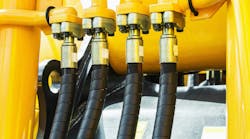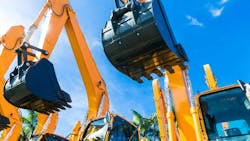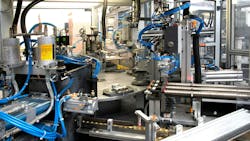Will Tariffs Alter the Business Outlook for Fluid Power?
After a difficult year for many in the fluid power industry and its various customer segments, there are signs of economic improvements in 2025 and beyond. In addition, there is a new presidential administration expected to bring a number of changes which could impact businesses in the coming years.
With a new presidential administration always comes the question of what policies will be put in place and how they will impact various industries. Of the policies discussed during president-elect Trump’s campaign, tariffs are potentially one of the most impactful policy initiatives put forth.
Tariffs present several potential implications to the hydraulics and pneumatics sector as well as its customer markets, many of which could influence the more positive conditions projected for 2025 and beyond.
Read the below articles to learn more about the factors pointing to more positive market conditions in 2025.
Tariffs Could Lead to Continued High Prices and Inventories
President-elect Trump has proposed tariffs of 10-20% on goods coming into the U.S. from any country, and another 60% on those from China to help bolster domestic manufacturing. Most recently, he has proposed tariffs of 25% on goods coming into the country from Canada and Mexico, two of the U.S.’s largest trading partners.
Some economists and industry associations, such as The Alliance for American Manufacturing, believe strategic use of tariffs could be beneficial to national and economic security by targeting their use in specific sectors where trade cheating is evident.
And a recent reader poll conducted by Industry Week, an Endeavor Business Media partner site, shows some manufacturing leaders support tariffs:
- 13.5% said they would like to see tariffs on incoming goods
- 9.7% indicated they would like to see higher tariffs on goods from China.
However, implementing tariffs typically leads to increased costs for manufacturers which are then passed on to their customers.
As Lauren Saidel-Baker, CFA, economist at ITR Economics said during the National Fluid Power Association’s (NFPA) Fall Economic Webinar, tariffs are inflationary which will impact pricing. “The goal of tariffs is to protect domestic production which is typically higher cost…by making cheaper foreign production more expensive,” she said. “So, whether you’re buying from the higher cost domestic producer or you’re paying more to import that foreign good, that is the point of tariffs, they raise prices.”
She noted there are various studies on the tariffs put in place during Trump’s first term regarding the exact impacts on prices of various goods but it is still too soon to measure the impact of the Biden administration’s recent tariffs on China.
In a recent LinkedIn post, Alastair Hayfield, Vice President of Research at Interact Analysis, analyzed the potential impact of tariffs on the U.S. off-highway machinery industry — one of the largest customer segments for fluid power. He said manufacturers often increase inventory levels ahead of tariffs; however, inventory levels at many OEMs are already high which makes adding more inventory difficult.
Tariffs, particularly those placed on goods from China, could cause higher prices for raw materials and components, leading to increased costs for OEMs and their end users he said.
As occurred during Trump’s first term, China and other countries subject to tariffs could retaliate with their own tariffs on U.S. produced goods. Mexico is one such example; the region has become the U.S.’s largest trading partner and many companies have moved manufacturing operations there as part of their nearshoring efforts. But because president-elect Trump has indicated wanting to place a 25% tariff on goods imported from Mexico, the country has indicated it may implement its own tariffs on U.S. goods which would again impact prices for purchasing those products.
What could this all mean for the hydraulics and pneumatics industry? Hayfield’s takeaway is that tariffs on Chinese goods could cause supply chain challenges for the off-highway machinery market as so many materials currently come from China, and it will be difficult to find alternative sources.
He sees many manufacturers in this sector continuing to take a wait-and-see approach to see how tariffs play out and passing on any added costs associated with them to end users if required.
Will Tariffs Lead to a Buildup of Domestic Manufacturing?
As noted, Trump’s goal of implementing tariffs is to encourage manufacturers to produce their goods in the U.S. But again, whether this goal will be achieved is uncertain.
Efforts to reshore and nearshore manufacturing have risen in recent years, brought on by the supply chain challenges experienced during the COVID-19 pandemic. And when Trump implemented tariffs during his first term, some companies did bring production back to the U.S.
However, there are also many companies who are unable to do so. For some goods it is just not feasible to produce them in the U.S. Cost plays a role in this. Industry Week reports Black & Decker’s CEO stated in an earnings call that it was unlikely the company would move much manufacturing back to the U.S. due to tariffs because it is not cost effective to do so. Added to this is the question of whether there is enough labor to support the country’s manufacturing industry.
Read more on the potential impacts of tariffs on various industries from other Endeavor Business Media publications.
How Trump's presidency could impact the plastics recycling landscape from Plastics Machinery & Manufacturing
Advice for Manufacturers Navigating Tariff Increases from AutomationWorld
Tariffs, Inflation, & IIJA in a Trump Administration from Construction Equipment
Trump’s Tariff Proposals Could Be Very Costly from Material Handling & Logistics
Here's what another Trump presidency means for trucking from FleetOwner
Survey: More Than Two-Thirds of Leaders Aim to Pass On Tariff Impacts from IndustryWeek
Labor is an important part of the equation as manufacturing and many other sectors are still facing a shortage of skilled labor which is not likely to change any time soon. Saidel-Baker noted during the NFPA economic webinar that the Gen Z and Millennial generations are smaller than previous ones, making it difficult to count on them to fill the gaps being left by older generations leaving the labor market.
Even with immigration, she said the labor market will remain challenged. Investing in technology such as robotics and automation will be necessary to overcome this — and would present opportunities for fluid power as pneumatics in particular are used in various types of robots and manufacturing machinery.
Jeff Burnstein, President of the Association for Advancing Automation (A3), said in a letter to president-elect Trump that he hopes there will be support for robotics and automation, the physical manifestations of artificial intelligence (AI) — an emerging technology Trump stated in his campaign platform he plans to champion during his term as president.
Burnstein notes the well-paying jobs these technologies can provide as well as their ability to make manufacturing operations safer and more productive, all of which will benefit the manufacturing sector and supply chains.
Another aspect that needs to be considered is the fact labor costs tend to be cheaper in other countries, which is why so much manufacturing left the U.S. in the first place. This is likely to prevent many companies from moving their operations.
Interact Analysis’ Hayfield pointed to the example of John Deere which recently moved more production to Mexico even though a Trump administration and tariffs were possible. He said companies take a long-term view of where to locate their production and as Mexico and other regions offer a lower cost option for manufacturing goods, tariffs are not likely to change reshoring plans in the immediate future.
Added to this is the cost and time associated with establishing new facilities. Even if a company chooses to bring production back to the U.S. it can take years for the effects of that to occur.
Investments in the manufacturing sector, however, could help bolster U.S. manufacturing. The CHIPS and Science Act, for instance, has helped to build up domestic production of semiconductors and many facilities are starting to come online now according to Saidel-Baker. This is providing a domestic opportunity for the fluid power industry she said as well as a long-term win for reshoring efforts.
The Alliance for American Manufacturing said it hopes the Trump administration will back similar manufacturing investments, especially in critical industries as well as in innovation and infrastructure, all of which will benefit U.S. goods production.
Ultimately, it likely remains a wait-and-see environment for the fluid power industry and many other business sectors. Tariffs are almost a certainty within the first days of the Trump administration said Nate Bolin, a partner at the law firm K&L Gates, during an election results webinar hosted by the American Gear Manufacturers Association (AGMA), because the president-elect and his team have an agenda focused on them.
But how exactly they will be enforced and on what goods remains to be seen. Bolin said that now is the time to ensure you understand your supply chain and workforce in the U.S. to best determine how your business could be impacted by tariffs.
About the Author
Sara Jensen
Executive Editor, Power & Motion
Sara Jensen is executive editor of Power & Motion, directing expanded coverage into the modern fluid power space, as well as mechatronic and smart technologies. She has over 15 years of publishing experience. Prior to Power & Motion she spent 11 years with a trade publication for engineers of heavy-duty equipment, the last 3 of which were as the editor and brand lead. Over the course of her time in the B2B industry, Sara has gained an extensive knowledge of various heavy-duty equipment industries — including construction, agriculture, mining and on-road trucks —along with the systems and market trends which impact them such as fluid power and electronic motion control technologies.
You can follow Sara and Power & Motion via the following social media handles:
X (formerly Twitter): @TechnlgyEditor and @PowerMotionTech
LinkedIn: @SaraJensen and @Power&Motion
Facebook: @PowerMotionTech

Leaders relevant to this article:






